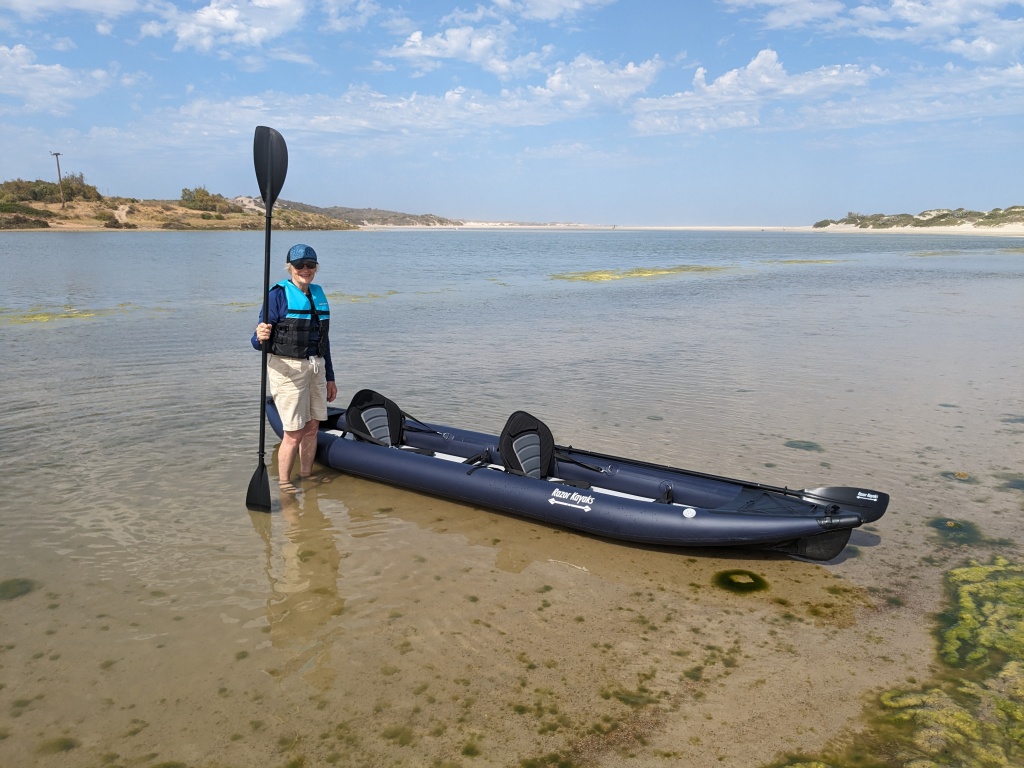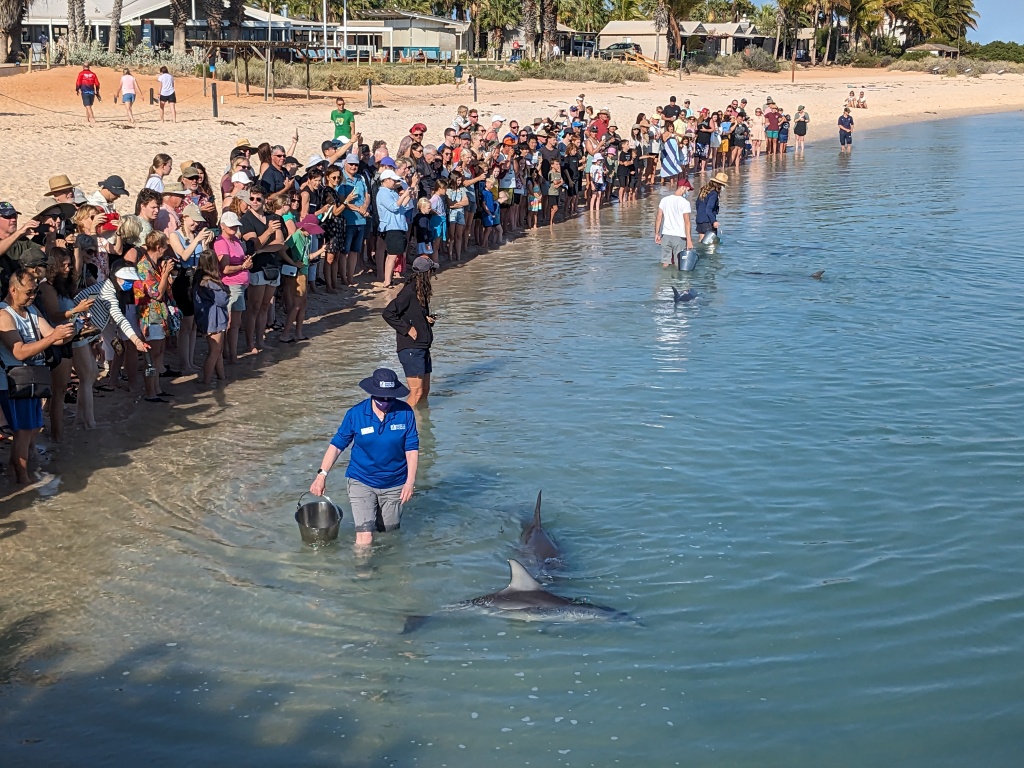Wildflowers, sea cliffs and gorges

Wildflower Hunting
The days roll on when you travel. Sometimes it’s hard to remember what you did a few days ago. The photos help though and we have seen some beautiful sights in the area between Perth and Shark Bay. We sought wildflowers from Kalgoorlie west, then north, travelling up through towns of assorted sizes many of them starting with the letter M: Mukinbudin, Koorda, Moora, Coorow, Three Springs, Carnamah, Mingenew and Mullewa. Along the way we stopped to take short walks and overnighted in some free or excellent council run camping grounds with fellow nomads, not all of them grey. Sadly, lack of winter rain meant a poorer display of wildflowers than other years. No carpets of everlastings. We were also a bit late for this area they call the Everlastings Trail. Despite this, we saw a few gems, especially on a wildflower loop near Koorda. The standout bush was the Koorda Rose and later a rare pinkish red flowering gum ((Rose Mallee – Eucalyptus Rhodantha) at Three Springs.




Coalseam Conservation Park
The nicest place we stayed in this inland stretch was Breakaway campground at Coalseam Conservation Park. This is stark, red soil country seeped in the history of unprofitable coalseam mining. You can see the black coal bands in sections where the Irwin River has carved a striking cliff face into the Victoria Plateau. Only a few hardy flowers but a remarkable number of birds including the singing honeyeater which we saw and heard many times. Wind and flies were occasional drawbacks. Fly nets do work though!



Cape Burney
Our intention was to go further north to Kennedy Range National Park but the weather forecast was dire, very hot (42 degrees) on the days we would be there. It was an easy decision to turn west after Mullewa and drive to Geraldton and a camping ground a few kilometres south at Cape Burney near the Greenough River. This was a chance to launch the new inflatable Razor Kayak as the estuary waters of the river are shallow and sheltered. The launch was successful and we were soon kayaking with the pelicans.


Geraldton
Geraldton is a large centre. They have an excellent museum which features detailed information about the wreck of the Batavia and subsequent mutiny in 1629 and the sinking of HMAS Sydney II in WW2. A well designed memorial on a high point commemorates the significant loss of life, 645 crew members, when the Sydney was sunk by a German boat laying mines off the WA coast in November 1941. A big centre such as Geraldton is also an opportunity to stock up on supplies and use the library for a strong WiFi connection.


Kalbarri
We headed to Kalbarri next – sea cliffs and inland gorges. The sea cliffs can be viewed from a number of lookouts on the coastal drive. First we stopped at Hutt Lagoon or Pink Lake. The lake is given its pink hue by carotenoid-producing algae. A popular place for selfies. The coastal cliffs are impressive and stretches of boardwalk have been built so you can walk along the cliff tops. My favourite was Pot Alley. We visited this small cove and cliff area in the late afternoon. The sea surged onto the beach and swirled into a blow hole with great force sending spray arching up and catching the sun. Ideal for photography.







The highlight for Chris at Kalbarri will be Collingwood winning the AFL Grand Final. We watched this in the camp kitchen of the Kalbarri Caravan Park with about twenty other people. Only a few wanted Collingwood to win but the atmosphere was friendly.

Kalbarri National Park
Kalbarri National Park is inland from the coast. This is the country of the Nanda people where the Murchison River has carved steep sided gorges over 400 million years. A skywalk has been constructed that hangs in mid-air 100 metres above the gorge. This engineering marvel has been constructed in consultation with the Nanda people. It’s weathered steel blends with the sandstone landscape. Numerous paths are designed so that the gorges and cliffs can be viewed from different locations. Another popular photography point was Nature’s Window; the tourists were lined up here for a compulsory photo.





Shark Bay
Some months ago, we had made a booking in Denham at Shark Bay Caravan Park aware that we would be there in school holidays. Denham was a busy place and we arrived on a very windy day. Fortunately the next six days were calmer. The sun shone, the breezes were mild and the temperature hovered in the high twenties. This made for ideal conditions for the kayak which had two outings, the first on the inlet to Little Lagoon and the lagoon itself, and the second on Big Lagoon. These lagoons were once land-locked salt pans (birridas) that were inundated by the sea thousands of years ago. White sand, pale green water on the shallow edge, darker deeper water where the sea grass grows. Our paddle across Big Lagoon brought us closer to red rock sea cliffs; the contrast with the different coloured water was stunning. Getting to Big Lagoon, located in Frances Peron National Park (he was here in 1801) involved a 20 kilometre sandy 4-wheel drive track. To tackle this we had to deflate our tyres to avoid getting bogged. We gave a lift to a hitch-hiking couple, Jules (French) and Connie (Austrian). Memories of our own hitch-hiking days probably prompted this offer. They were good company.








Day out on Shark Bay
The next day, we’d booked a big day out on the bay with Shark Bay Dive and Marine Safaris. The weather was perfect, the group small and the activities manageable for two in their early to mid- seventies. The boat took us to Steep Point the western most point of Australia. We experienced several humpback whale sightings, a dugong, eagle rays, dolphins, a cormorant colony and a 400 year-old osprey nest. The snorkeling in clear sheltered water was good: some colourful coral, star fish and small fish, particularly around a small rocky island. We also snorkelled from the boat onto Dirk Hartog Island, the site of the first recorded European landing on Australian soil in 1616. The Dutch were definitely here first! Both the island and Francois Peron National Park have benefitted from Project Eden an attempt to reverse ecological destruction and the extermination of native mammals. Livestock, foxes, rabbits and cats have been eliminated on Dirk Hartog Island and, at this stage, five mammals successfully reintroduced. Heartening. We didn’t see any sharks on this day out on the water but had good views of the nervous shark swimming in the shallow water below Eagle Bluff as we left the bay.







Monkey Mia
Of course a visit to Shark Bay wouldn’t be complete without seeing the dolphins at Monkey Mia Resort. I was sceptical about this, but the dolphins are fed only a small portion of what they need to survive each day and the crowd is kept under tight control. It was great to see these sleek creatures up close and personal. So the journey so far has been a history lesson, a geology lesson and a lesson in projects that are aiming to reclaim what has been lost.






Milligan’s Island
We had one more stay on the coast at Milligan’s Island. A great camping ground but oh the wind. It was time to head inland to Lesueur NP in search of more wildflowers and some shady trees.





It’s great to be travelling with you across and up and down this big land Bev and Chris, albeit via your blog.
The joy on your faces tells it all, especially your adventures in kayaking and snorkeling.
The early wild flowers are spectacular and unusual, particularly the Koorda Rose and Mallee Rose.
Thanks for the lessons too!
M and G
LikeLike
Thanks Maree. All the glossy bits of course, but you understand that.
LikeLike